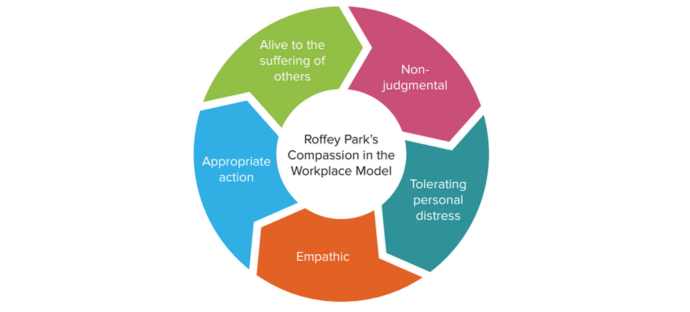Recent research and findings have recognized compassion to be an essential aspect of a productive work environment. Showing compassion to colleagues is vital to sustaining job satisfaction and work-related motivation.
What is Compassionate Leadership?
The Latin root of the word compassion means to struggle (or suffer) with. Compassion balances caring, concern, empathy, and transparency with boundaries, goals, aspirations, and standards. Compassionate Leadership is the practice of using your head and heart to inspire and influence people so they can, in turn, inspire and influence others.
Harvard Business Review created an assessment to help leaders identify their levels of compassion. The evaluation is self-scorable and gives an accurate judgment of whether or not we can call ourselves compassionate leaders. You can take the test here
5 aspects of Compassionate leadership

Roffey Park’s Compassion Workplace Model states that there are five aspects of compassionate leadership and management (Poorkavoos, 2016):
- Being aware of the needs of others.
- Being non-judgmental to the viewpoints of others.
- Being resilient and tolerant toward personal distress.
- Feeling and showing empathy at all levels of professional life.
- Being accountable and responsible for all good and bad outcomes of the team.
It is clear to see that compassionate leaders are preferred more among employees, and more popular among clients as they are more comfortable to talk to, and more positive in giving honest feedback.
Why is it important to express compassion with your teammates?

The benefits of being compassionate at work are vast. Here are the top 3 advantages compassionate leadership brings to you:
1. Employee engagement & retention
Employees who receive empathy, understanding, and help from their colleagues and superiors are likely to stay in the organization for a long period of time and install all their efforts for the benefit of the organization.
2. Improve overall well-being
Working with compassionate and kind people gives employees the chance to manage work stress and burnout. When people exchange positivity and bond with each other at work, their stress level significantly reduces. Compassion provides the ideal conditions for team members to work productively, grow faster, and improve their overall well-being.
3. Build authentic, trust-based relationships
In addition, employees also form healthy and strong professional relationships and feel comfortable working as a part of the team. Exchanging compassion promotes generosity, collaboration, and connection and builds the affective commitment of the workers toward their superiors and the institution as a whole.
So how can you respond with more compassion the next time an employee makes a serious mistake?

1. Listen actively
Making eye contact, giving nonverbal feedback, using your body language affirmatively, and focusing on the conversation. This principle of compassionate leadership helps you earn your team’s trust and make them feel at ease to share their problems.
2. Take a moment The first thing is to get a handle on your own emotions — anger, frustration, or whatever the case may be. By stepping back and taking a period of time to reflect to cool off so you can see the situation with more detachment.
3. Put yourself in your employee’s shoes Taking a step back will give you the ability to empathize with your employee. As a consequence of recalling your own first work experience, you could identify and empathize with employees. The ability to change perspective is a valuable one. Studies have shown that it helps you see aspects of the situation you may not have noticed and leads to better results in interactions and negotiations.
4. Forgive
Forgiveness not only strengthens your relationship with your employee by promoting loyalty, but it turns out that it is also good for you. Forgiveness makes you happier and more satisfied with life, significantly reducing stress and negative emotions.
5. Paraphrasing
Use your own words to let the other person know what you think they meant. You can start with “I understand that you… “. Avoid interpreting or jumping too far ahead of what the person has said.
6. Build an open and judgment-free space
Encourage your employee to have space for self-reflection. It allows individuals to think through workplace experiences, consider their actions and explore motivations, assumptions or biases that may have impacted their approach.
7. Take responsibility for the mistake
One key to leadership is the willingness to stand up and take responsibility for your team’s mistakes. Acknowledge them. Collaborate with your team to find a solution to prevent this mistake from happening again. This step will put a dynamic of continuous improvement that will inspire your team to take calculated risks to grow together.
8. Hold the employee accountable (to avoid the mistake next similar situations happen)
Each team member needs to know what is expected of them, how their contributions impact the larger team goal, and their peers' accountabilities and roles.
In conclusion, Compassionate leadership isn’t just about being nice at work. It’s much more. And it’s made up of habits we can practice every day. Keep in mind that great leaders are great communicators. It starts with active listening. Have you mastered Listening and Communication skills yet? If not, book our training to uncover your potential.
